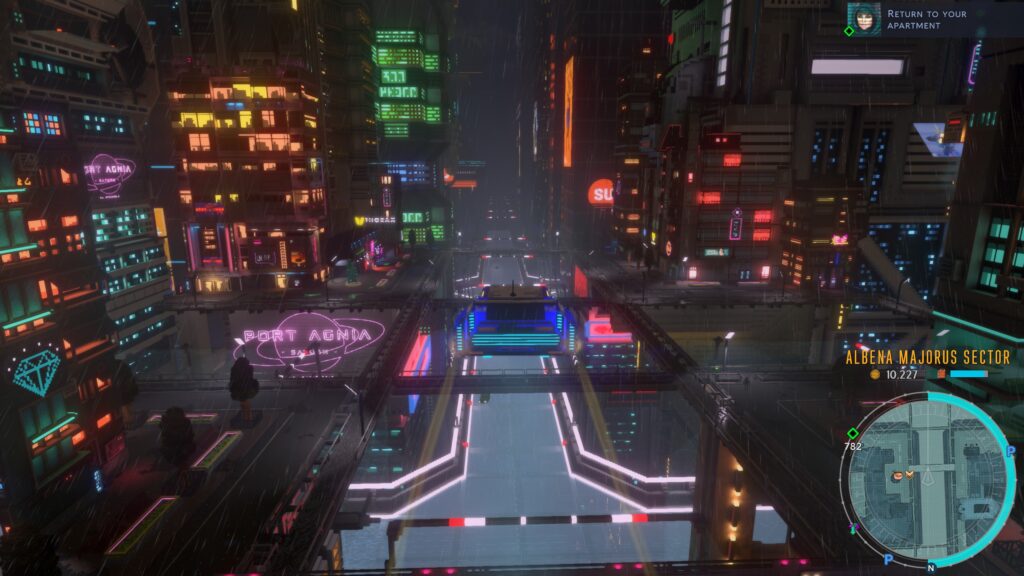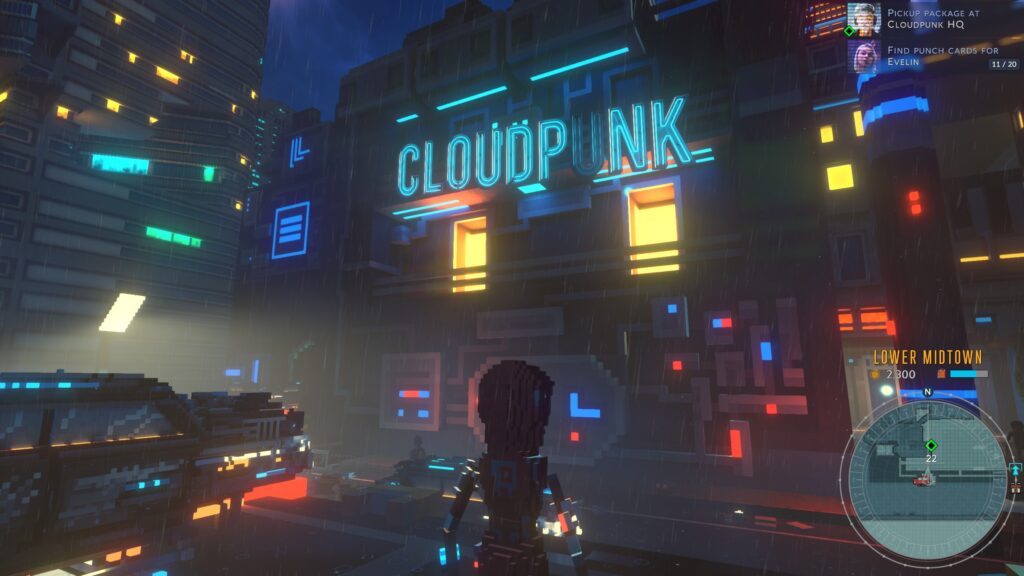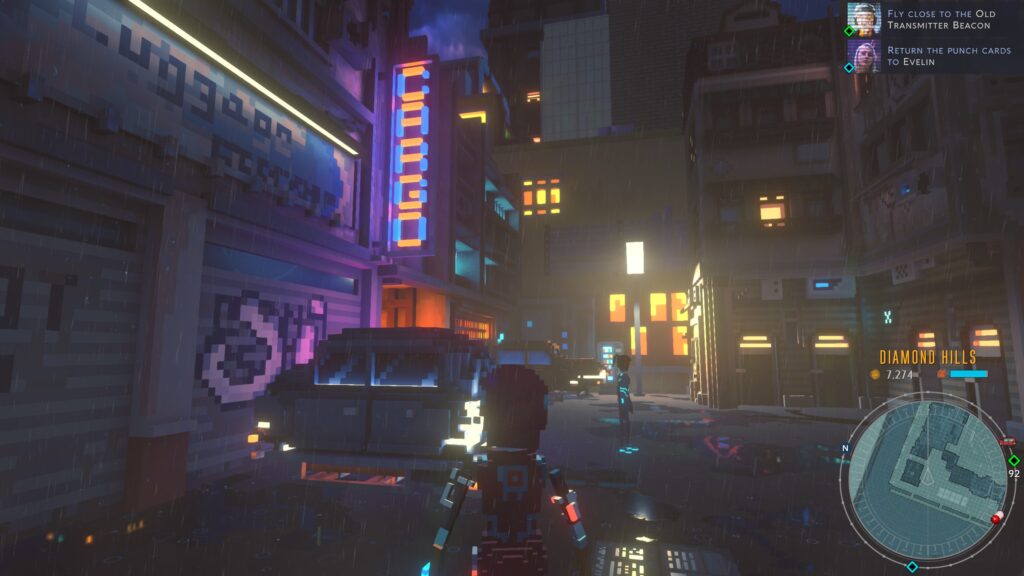
I’ve had my eye on this game pretty much as soon as I heard of it. The premise of playing as a delivery driver in a cyberpunk city sounded awesome to me and the visuals in this game certainly looks the part. Superficially one might describe it as a kind of sci-fi Grand Theft Auto but there’s no combat in this game at all and without the DLC, no racing either, so the comparison doesn’t really work. Instead it feels more like an adventure game as you explore and experience the story of the city and the people in it.
You are Rania, newly arrived in the mega-city of Nivalis and on the first day of your job as a driver for Cloudpunk. As the city consists of blocks of towers that stretch far into the clouds, the primary mode of transport are flying cars called HOVAs. Rania also brings with her an AI, or automata, dog named Camus. But as she had to sell his dog chassis as part of fleeing from the loan sharks at home, she installs Camus in her HOVA. Over the course of one rainy, seemingly endless night, Rania takes on many jobs assigned by her dispatcher called Control and gets to know the many sections of Nivalis as well as the different people who live in it. One of the more notable encounters she has is with an automata private detective named Huxley who talks only in the third person and is searching for a little girl. Rania also realizes the city itself is failing, its systems and infrastructure falling into disrepair as there is no longer anyone left alive who understands its systems. In between all this, she makes the time to stop by the small apartment she has rented in the city and perhaps try to make it into a home.

You do a fair amount of driving in this game as you zip around Nivalis delivering parcels and eventually even carrying passengers. You’ll have to navigate between floors of different heights, weave between buildings and since moving along the designated expressways gives you a speed boost, you’ll probably want to stay on them for as much as possible. But you might be surprised at how much walking you need to do as well. The HOVAs can only land in designated parking bays and there may be quite some distance between the bays and wherever it is you need to go. There might even a little bit of puzzle solving as you figure how to get to the correct nav point using walkways and elevators while picking up collectibles along the way. It can be frustrating just how much walking you need to do but it’s a great chance to get a closer look at some of the amazing sights in the city.
The city of Nivalis is indeed a real delight. At first, the blocky graphics might lead you to dismiss the city as an undifferentiated mass of towers and lights but it actually is a fully realized place. There are distinct neighborhoods, office towers, shops, highways, scenic points, landmarks, dodgy alleys, bridges and much more. As you talk to clients, the city too feels more real and lived-in. The quality of the writing can be uneven at times with some of the conversations being too obviously digs at current stereotypes and memes rather than something that belongs in an almost impossibly distant future. Still there are plenty of good stories in it too. I like how Nivalis feels to its inhabitants like a city that has always existed and is always decaying and no one left remembers a time before it. There are automatons, embodied or not, being exploited or just trying to get by like everyone, corrupt cops and greedy executives, crazy cultists and reckless racers, even survivalists trying to live off-grid and under the radar of the corps. This is a surprisingly long and rich storytelling experience for an indie game and it gets the cyberpunk feeling down perfectly.

The game’s biggest weakness is that mechanically the player has only very few ways in which to interact with the world. For example, there are many conversations but the game doesn’t even have a system for the player to select responses. When a choice needs to be made, and there are rather few of these, you simply decide where to go to deliver a package or activate a button. Similarly you can buy food but there are no in-game effects at all. It does feel satisfying to buy decorations and furniture for your apartment even if they do nothing so it’s not wrong to try to treat this as more an adventure game. But there is a tonal disconnect at times. The background chatter talks about accidents and crashes all of the time, but nothing of the sort actually happens in the game. It is in fact impossible to fatally crash your HOVA no matter how hard you try. There are gang members in the game but they are actually doing good deeds in defiance of the corps. There is no street violence at all and not even the slightest hint of anyone carrying weapons. A few missions are time sensitive, but for the most part this is a really chill game.
I understand that the DLC adds street racing which would make the HOVA upgrades you can purchase more meaningful, and you can play as more characters than just Rania. Ordinarily I skip all DLCs, but I think I will buy the one for this eventually. Limited as the game’s mechanics are, I really enjoyed the relaxed feeling of driving around the city and playing this made me realize how much I like synthwave music. I also grew emotionally invested enough in Rania’s story to want to know about her life as an established inhabitant of the city. Most of all however, what clinches my love for the story is that while Rania arrives in the city fearing the worst and her fears are indeed realized, she also learns that there are decent people in the city she can befriend and come to love and the city itself can be a beautiful place to build a new home. It’s a game that is somewhat limited in terms of gameplay but it has heart and an amazing sense of place. I’d highly recommend it as an unmatched cyberpunk experience.
